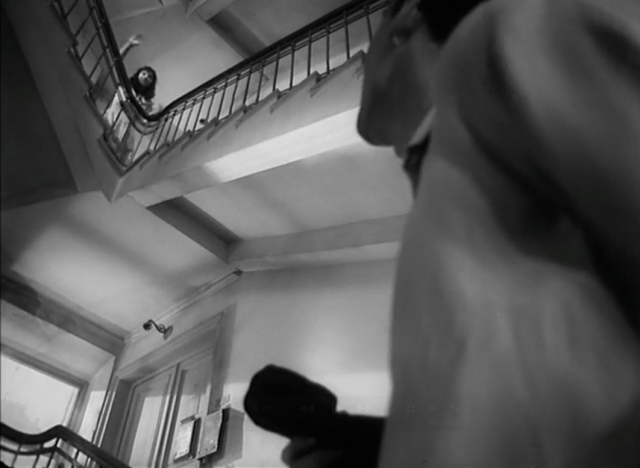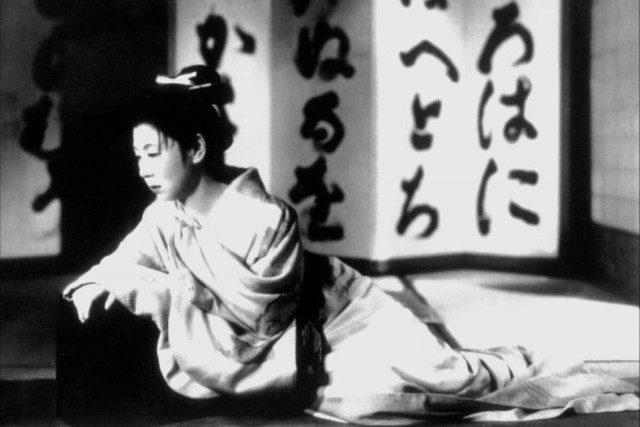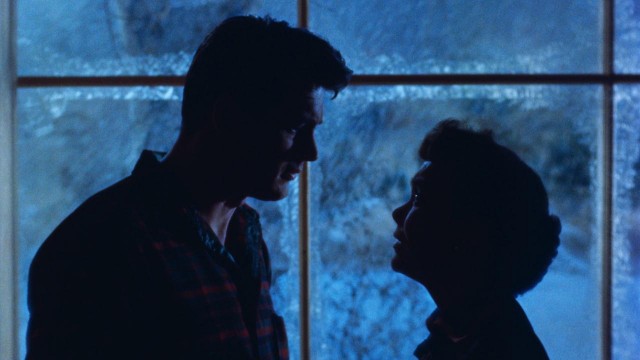
Rock Hudson and Jane Wyman star in Douglas Sirk’s gorgeous Technicolor emotional melodrama All That Heaven Allows
ALL THAT HEAVEN ALLOWS (Douglas Sirk, 1955)
Film Society of Lincoln Center, Walter Reade Theater, Francesca Beale Theater
144/165 West 65th St. between Eighth Ave. & Broadway
Wednesday, December 13, 6:30
Monday, January 1, 7:00
Series runs December 13 – January 6
212-875-5050
www.filmlinc.org
 Forget about It’s a Wonderful Life, Miracle on Thirty-Fourth Street, and endless versions of A Christmas Carol; our favorite holiday movie is Douglas Sirk’s sensationally strange and beautiful All That Heaven Allows, which you can see December 13 and January 1 as part of the Film Society of Lincoln Center’s four-week, fifty-four-movie, get-out-your-handkerchiefs series “Emotion Pictures: International Melodrama.” Rock Hudson and Jane Wyman, who played characters who fell in love in Sirk’s Magnificent Obsession, are at it again in All That Heaven Allows. This time around, Hudson is Ron Kirby, a softhearted, hunky gardener who prefers a simple, outdoorsy life yet is drawn to Cary Scott (Wyman), an older widow who is firmly entrenched in her community’s country-club lifestyle with her best friend, Sara (Agnes Moorehead). Kirby and Cary begin a passionate affair but when they decide to wed, the snooty members of the town’s social register are thoroughly appalled and do everything in their power to drive them apart because of class, wealth, and age differences. (At thirty-seven, Wyman was a mere eight years older than Hudson in real life.) Meanwhile, Cary’s kids, high schooler Kay (Gloria Talbott) and college student Ned (William Reynolds), find their mother’s impending marriage to Kirby disgusting and distasteful as well, preferring she marry Harvey (Conrad Nagel), a plain, sexless widower. In 1950s America, women were still subservient to the needs of men and to raising their children, not permitted by society to lead their own lives and make decisions for themselves, especially when it came to their sexuality. The film features an essentially nonreligious belief system that is embodied by Kirby, who is inspired by the writings on naturalism and the true meaning of success espoused by Henry David Thoreau in Walden. Indeed, the outside world is central to the film; Sirk and his longtime cinematographer, Russell Metty, let the camera linger on trees, lakes, snow banks, and deer. Flowers abound indoors and out, and windows always look out on beautiful scenery, as if paintings, accompanied by Frank Skinner’s equally lush score and Bill Thomas’s colorful costumes.
Forget about It’s a Wonderful Life, Miracle on Thirty-Fourth Street, and endless versions of A Christmas Carol; our favorite holiday movie is Douglas Sirk’s sensationally strange and beautiful All That Heaven Allows, which you can see December 13 and January 1 as part of the Film Society of Lincoln Center’s four-week, fifty-four-movie, get-out-your-handkerchiefs series “Emotion Pictures: International Melodrama.” Rock Hudson and Jane Wyman, who played characters who fell in love in Sirk’s Magnificent Obsession, are at it again in All That Heaven Allows. This time around, Hudson is Ron Kirby, a softhearted, hunky gardener who prefers a simple, outdoorsy life yet is drawn to Cary Scott (Wyman), an older widow who is firmly entrenched in her community’s country-club lifestyle with her best friend, Sara (Agnes Moorehead). Kirby and Cary begin a passionate affair but when they decide to wed, the snooty members of the town’s social register are thoroughly appalled and do everything in their power to drive them apart because of class, wealth, and age differences. (At thirty-seven, Wyman was a mere eight years older than Hudson in real life.) Meanwhile, Cary’s kids, high schooler Kay (Gloria Talbott) and college student Ned (William Reynolds), find their mother’s impending marriage to Kirby disgusting and distasteful as well, preferring she marry Harvey (Conrad Nagel), a plain, sexless widower. In 1950s America, women were still subservient to the needs of men and to raising their children, not permitted by society to lead their own lives and make decisions for themselves, especially when it came to their sexuality. The film features an essentially nonreligious belief system that is embodied by Kirby, who is inspired by the writings on naturalism and the true meaning of success espoused by Henry David Thoreau in Walden. Indeed, the outside world is central to the film; Sirk and his longtime cinematographer, Russell Metty, let the camera linger on trees, lakes, snow banks, and deer. Flowers abound indoors and out, and windows always look out on beautiful scenery, as if paintings, accompanied by Frank Skinner’s equally lush score and Bill Thomas’s colorful costumes.
It all makes for the kind of candy-coated America that David Lynch turned upside down and inside out in Blue Velvet and that directly influenced Todd Haynes’s 2002 Sirk homage, Far from Heaven, in which white Connecticut housewife Cathy Whitaker (Julianne Moore), who is married to a closeted white executive (Dennis Quaid), becomes perhaps too friendly with her black gardener (Dennis Haysbert), a melding of All That Heaven Allows and Sirk’s Imitation of Life. (Both Far from Heaven and Imitation of Life are part of the series as well.) At one point, Kirby talks about how his best friend learned to be his own man. “And you want me to be a man,” Cary says. “Only in that one way,” Kirby responds, playfully looking over at Cary; it’s as if Hudson is teasing her about his real-life sexuality. People’s double nature is reflected throughout, as Sirk and Metty use fireplace screens, windshields, mirrors, and even a television set to create physical separation between characters as well as the inner and outer parts of the same character. In addition, there is a vast array of ties, cravats, scarves, ascots, bow ties, and other articles of clothing that everyone wears around their necks, as if their true feelings are always being choked and hidden. It’s a magnificent film, richly textured and multilayered, not nearly as cynical and tongue-in-cheek as some claim it to be. All That Heaven Allows is screening December 13 and January 1 in “Emotion Pictures: International Melodrama,” which divides its films into four categories: Silent Screen, Hollywood’s Golden Age, International Classics, and Modern/Postmodern Drama, with works by Yasujirô Ozu, Martin Scorsese, Pier-Paolo Pasolini, Charlie Chaplin, Pedro Almodóvar, Clint Eastwood, Federico Fellini, Youssef Chahine, David Lean, Rainer Werner Fassbinder, Vincente Minnelli, Max Ophüls, and many more.
THE CRANES ARE FLYING (Mikhail Kalatozov, 1957)
Sunday, December 17, 4:00
Saturday, December 30, 3:30
www.filmlinc.org
 Even at a mere ninety-seven minutes, Mikhail Kalatozov’s The Cranes Are Flying is a sweeping Russian antiwar epic, an intimate and moving black-and-white tale of romance and betrayal during WWII. Veronika (Tatyana Samojlova) and Boris (Aleksey Batalov) are madly in love, swirling dizzyingly through the streets and up and down a winding staircase. But when Russia enters the war, Boris signs up and heads to the front, while Veronika is pursued by Boris’s cousin, Mark (Aleksandr Shvorin). Pining for word from Boris, Veronika works as a nurse at a hospital run by Boris’s father, Fyodor Ivanovich (Vasili Merkuryev), as the family, including Boris’s sister, Irina (Svetlana Kharitonova), looks askance at her relationship with Mark. The personal and political intrigue comes to a harrowing conclusion in a grand finale that for all its scale and scope gets to the very heart and soul of how the war affected the Soviet people on an individual, human level, in the family lives of women and children, lovers and cousins, husbands and wives.
Even at a mere ninety-seven minutes, Mikhail Kalatozov’s The Cranes Are Flying is a sweeping Russian antiwar epic, an intimate and moving black-and-white tale of romance and betrayal during WWII. Veronika (Tatyana Samojlova) and Boris (Aleksey Batalov) are madly in love, swirling dizzyingly through the streets and up and down a winding staircase. But when Russia enters the war, Boris signs up and heads to the front, while Veronika is pursued by Boris’s cousin, Mark (Aleksandr Shvorin). Pining for word from Boris, Veronika works as a nurse at a hospital run by Boris’s father, Fyodor Ivanovich (Vasili Merkuryev), as the family, including Boris’s sister, Irina (Svetlana Kharitonova), looks askance at her relationship with Mark. The personal and political intrigue comes to a harrowing conclusion in a grand finale that for all its scale and scope gets to the very heart and soul of how the war affected the Soviet people on an individual, human level, in the family lives of women and children, lovers and cousins, husbands and wives.
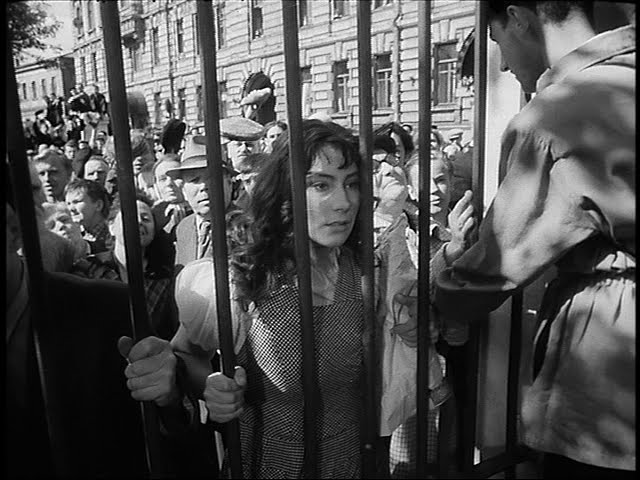
Unforeseen circumstances trap Veronika (Tatyana Samojlova) in wartime Russia in Mikhail Kalatozov’s masterful The Cranes Are Flying
The only Russian film to win the Palme d’Or at Cannes by itself, The Cranes Are Flying is a masterful work of art, a searing portrait of the horrors of war as seen through the eyes of one desperate woman. Adapting his own play, Viktor Rozov’s story sets up Boris and his family as a microcosm of Soviet society under Stalin; it’s no coincidence that the film was made only after the leader’s death. It’s a whirlwind piece of filmmaking, a marvelous collaboration between director Kalatozov, editor Mariya Timofeyeva (Ballad of a Soldier), composer Moisey Vaynberg (the opera The Passenger), and cinematographer Sergey Urusevsky, who also worked with Kalatozov on I Am Cuba and The Unsent Letter; Urusevsky’s camera, often handheld, is simply dazzling, whether moving through and above crowd scenes, closing in on Samojlova’s face and Batalov’s eyes, or twirling up at the sky. Poetic and lyrical, heartbreaking and maddening, The Cranes Are Flying is an exquisite example of the power of cinema. You can see it December 17 and 30 in the Film Society of Lincoln Center series “Emotion Pictures: International Melodrama,” which also features works by D. W. Griffith, F. W. Murnau, Oscar Micheaux, Nicholas Ray, George Cukor, Ida Lupino, Leo McCarey, Ritwik Ghatak, Mikio Naruse, Jacques Demy, Lars von Trier, Guy Maddin, and many more.
THE LIFE OF OHARU (SAIKAKU ICHIDAI ONNA) (Kenji Mizoguchi, 1952)
Monday, December 18, 1:30
Saturday, January 6, 3:45
www.filmlinc.org
 We used to think that Aki Kaurismäki’s The Match Factory Girl was the saddest film ever made about a young woman who just can’t catch a break, as misery after misery keeps piling up on her ever-more-pathetic existence. But the Finnish black comedy has nothing on Kenji Mizoguchi’s The Life of Oharu, a searing, brutal example of the Buddhist observation of impermanence and the role of women in Japanese society. The film, based on a seventeenth-century novel by Ihara Saikaku, is told in flashback, with Oharu (Kinuyo Tanaka) recounting what led her to become a fifty-year-old prostitute nobody wants. It all starts to go downhill after she falls in love with Katsunosuke (Toshirô Mifune), a lowly page beneath her family’s station. The affair brings shame to her mother (Tsukie Matsuura) and father (Ichiro Sugai), as well as exile. The family is redeemed when Oharu is chosen to be the concubine of Lord Matsudaira (Toshiaki Konoe) in order to give birth to his heir, but Lady Matsudaira (Hisako Yamane) wants her gone once the baby is born, and so she is sent home again, without the money her father was sure would come to them.
We used to think that Aki Kaurismäki’s The Match Factory Girl was the saddest film ever made about a young woman who just can’t catch a break, as misery after misery keeps piling up on her ever-more-pathetic existence. But the Finnish black comedy has nothing on Kenji Mizoguchi’s The Life of Oharu, a searing, brutal example of the Buddhist observation of impermanence and the role of women in Japanese society. The film, based on a seventeenth-century novel by Ihara Saikaku, is told in flashback, with Oharu (Kinuyo Tanaka) recounting what led her to become a fifty-year-old prostitute nobody wants. It all starts to go downhill after she falls in love with Katsunosuke (Toshirô Mifune), a lowly page beneath her family’s station. The affair brings shame to her mother (Tsukie Matsuura) and father (Ichiro Sugai), as well as exile. The family is redeemed when Oharu is chosen to be the concubine of Lord Matsudaira (Toshiaki Konoe) in order to give birth to his heir, but Lady Matsudaira (Hisako Yamane) wants her gone once the baby is born, and so she is sent home again, without the money her father was sure would come to them.
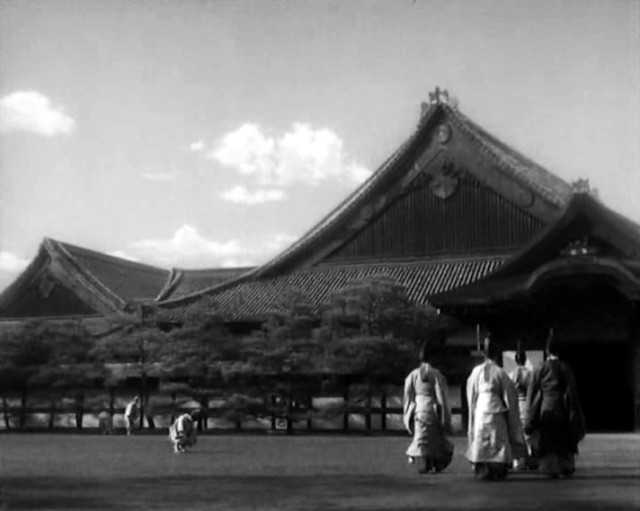
Mizoguchi’s The Life of Oharu is an elegant film about one woman’s struggle to survive in a cold world
Over the next several years, Oharu becomes involved in a series of personal and financial relationships, each one beginning with at least some hope and promise for a better future but always ending in tragedy. Nevertheless, she keeps on going, despite setback after setback, bearing terrible burdens while never giving up. Mizoguchi (Sansho the Bailiff, The 47 Ronin, Street of Shame) bathes much of the film in darkness and shadow, casting an eerie glow over the unrelentingly melodramatic narrative. Tanaka, who appeared in fifteen of Mizoguchi’s films and also became the second Japanese woman director (Love Letter, Love Under the Crucifix), gives a subtly compelling performance as Oharu, one of the most tragic figures in the history of cinema. Winner of the International Prize at the 1952 Venice International Film Festival, The Life of Oharu is screening December 18 and January 6 in the Film Society of Lincoln Center series “Emotion Pictures: International Melodrama,” which also features works Teuvo Tulio, Fei Mu, George Kuchar, Todd Haynes, Wong Kar Wai, Terence Davies, Leos Carax, Wu Yonggang, Robert Stevenson, and many more.
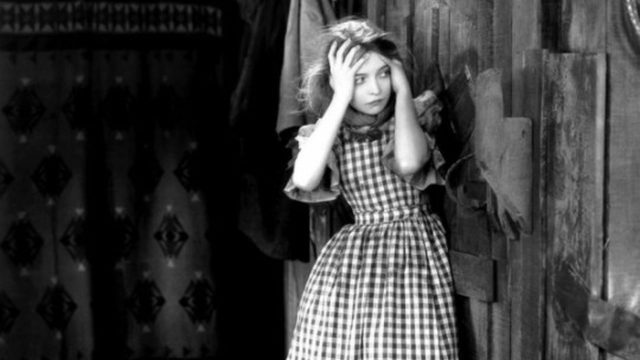
Letty Mason (Lillian Gish) is being driven crazy by internal and external sources in The Wind
THE WIND (Victor Sjöström, 1928)
December 19, 8:30
www.filmlinc.org
 Victor Sjöström’s 1928 now-classic silent film The Wind stars Lillian Gish as Letty Mason, a young woman traveling from Virginia to Texas to live with her cousin Beverly (Edward Earle). Traveling from the cultured, civilized East to what was still the wild West, the uncertain Letty must confront the fierceness of nature head-on — both human nature and the harsh natural environment. On the train, she is wooed by cattleman Wirt Roddy (Montagu Love), but her fears grow as she first sees the vicious wind howling outside the train window the closer she gets to her destination. Once in Sweetwater, she is picked up by her cousin’s neighbors, the handsome Lige Hightower (Lars Hanson), and his goofy sidekick, Sourdough (William Orlamond). Both men take a quick liking to Letty, who seems most attracted to Wirt. Soon Beverly’s wife, Cora (Dorothy Cumming, in her next-to-last film before retiring), becomes jealous of Letty’s closeness with her husband and kids and kicks her out, leaving a desperate Letty to make choices she might not be ready for as the wind outside becomes fiercer and ever-more dangerous. The Wind is a tour de force for Gish in her last silent movie, not only because of her emotionally gripping portrayal of Letty but because she put the entire production together, obtaining the rights to the novel by Dorothy Scarborough, hiring the Swedish director and star Hanson, and arguing over the ending with the producers and Irving Thalberg. (Unfortunately, she lost on that account, just about the only thing that did not go the way she wanted.)
Victor Sjöström’s 1928 now-classic silent film The Wind stars Lillian Gish as Letty Mason, a young woman traveling from Virginia to Texas to live with her cousin Beverly (Edward Earle). Traveling from the cultured, civilized East to what was still the wild West, the uncertain Letty must confront the fierceness of nature head-on — both human nature and the harsh natural environment. On the train, she is wooed by cattleman Wirt Roddy (Montagu Love), but her fears grow as she first sees the vicious wind howling outside the train window the closer she gets to her destination. Once in Sweetwater, she is picked up by her cousin’s neighbors, the handsome Lige Hightower (Lars Hanson), and his goofy sidekick, Sourdough (William Orlamond). Both men take a quick liking to Letty, who seems most attracted to Wirt. Soon Beverly’s wife, Cora (Dorothy Cumming, in her next-to-last film before retiring), becomes jealous of Letty’s closeness with her husband and kids and kicks her out, leaving a desperate Letty to make choices she might not be ready for as the wind outside becomes fiercer and ever-more dangerous. The Wind is a tour de force for Gish in her last silent movie, not only because of her emotionally gripping portrayal of Letty but because she put the entire production together, obtaining the rights to the novel by Dorothy Scarborough, hiring the Swedish director and star Hanson, and arguing over the ending with the producers and Irving Thalberg. (Unfortunately, she lost on that account, just about the only thing that did not go the way she wanted.)
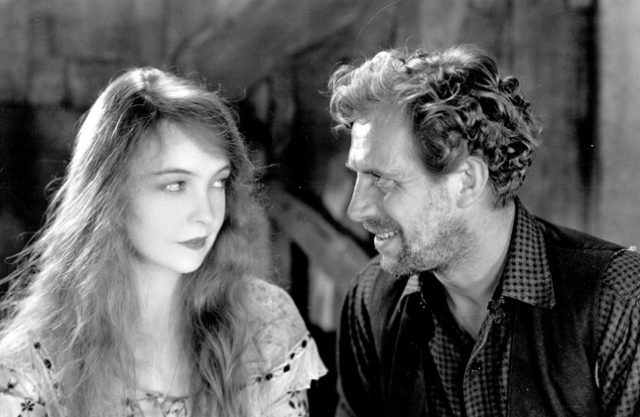
Letty Mason (Lillian Gish) and Lige Hightower (Lars Hanson) have some tough decisions to make in Victor Sjöström’s silent classic
Sjöström (The Phantom Carriage, The Divine Woman), who played Professor Isak Borg in Ingmar Bergman’s Wild Strawberries, and cinematographer John Arnold create some dazzling effects as a twister threatens and Letty battles both inside and outside; she is regularly shot from the side, at the door of the shack where she lives, not knowing if she’d be safer inside or outside as the wind and sand blast over her. The film, an early look at climate change, was shot in the Mojave Desert in difficult circumstances; to get the wind to swirl, the crew used propellers from eight airplanes. Dialogue is sparse, and the story is told primarily in taut visuals. A restored 35mm print of The Wind with the original music and effects soundtrack is screening December 19 in the Film Society of Lincoln Center series “Emotion Pictures: International Melodrama.”
